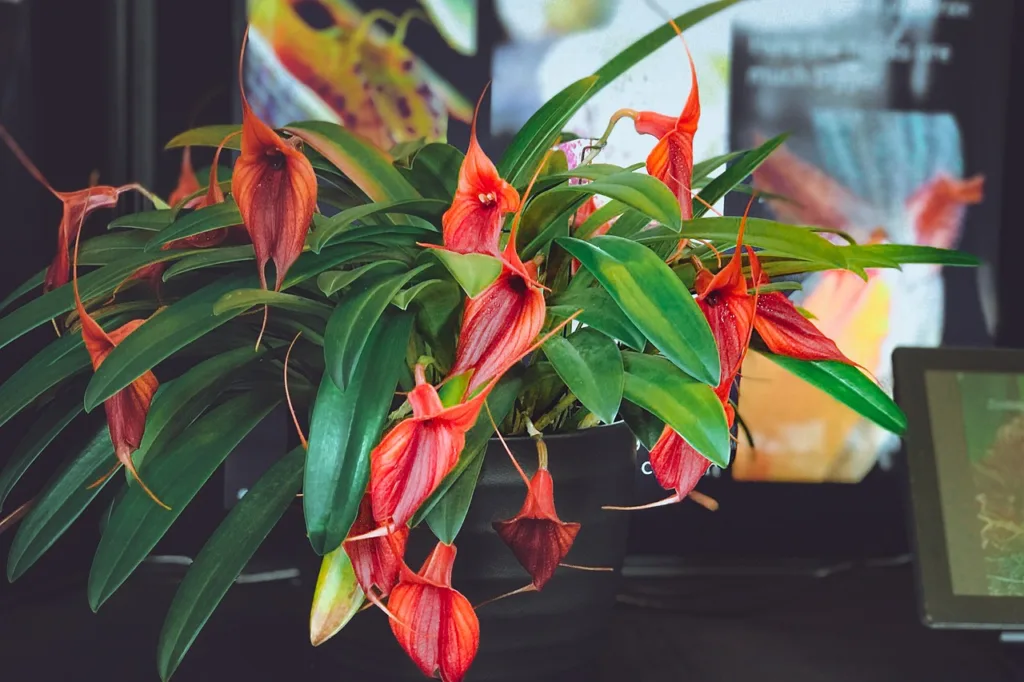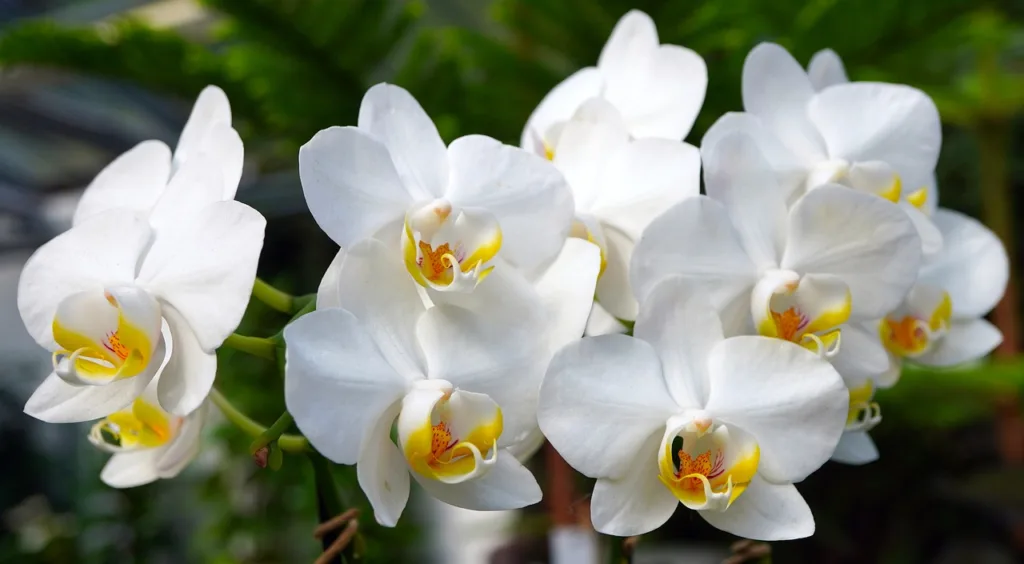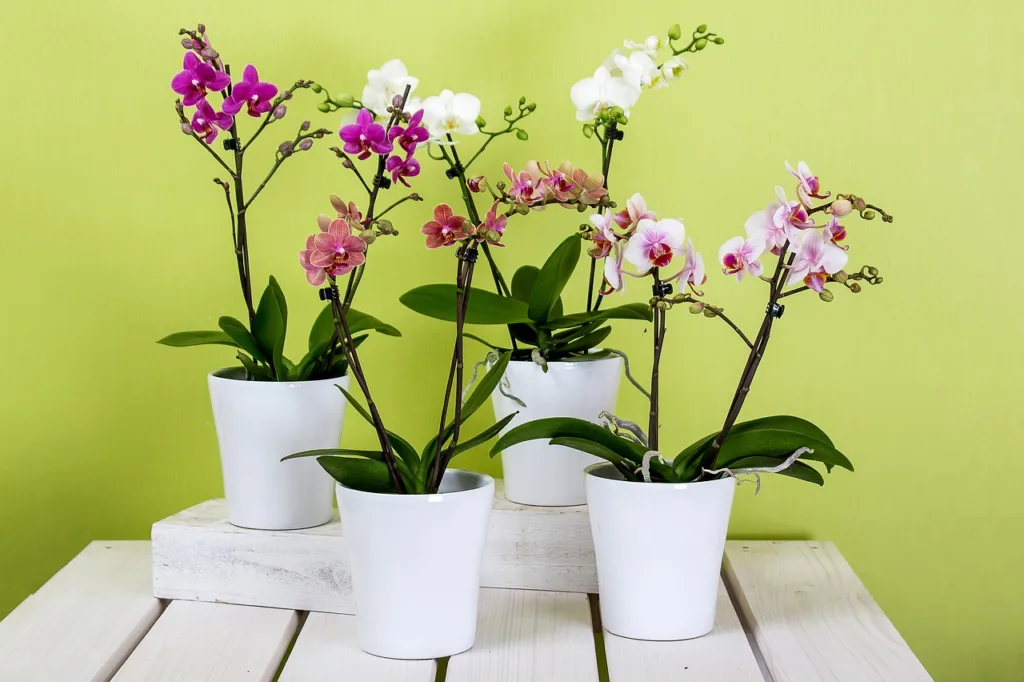Orchid flowers are beautiful and charming and can bring a touch of beauty to any home or garden. While they may seem delicate, with the right care and attention, anyone can successfully grow and maintain these stunning plants.
Orchid flowers are flowers produced by plants belonging to the Orchidaceae family, one of the largest and most diverse plant families.
Orchids are famous for their hardy and often showy flowers, which display a wide range of shapes, sizes, and colors. Flowers usually have three outer sepals and three inner petals, of which one petal, known as the lip or labellum, often exhibits a specialized and elaborate shape.
Orchid flowers are highly valued for their beautiful appeal and they are a focal point in gardening as both ornamental plants and cut flowers.
They are found throughout the world in a variety of habitats, ranging from tropical rainforests to temperate forests. Orchids can be epiphytic (growing on other plants), terrestrial (growing in soil), or lithophytic (growing on rocks).
Beyond their visual appeal, orchids present fascinating ecological adaptations, including specialized pollination mechanisms. Some orchids have developed specific relationships with pollinators such as bees, moths, or birds, ensuring successful reproduction of the plant.
Orchids hold cultural significance, symbolizing beauty, love, luxury, and strength. They are widely used in the gardening trade and are popular choices for indoor and outdoor gardens.
Despite their popularity, many orchid species face threats, including habitat destruction and over-collection, leading to conservation efforts to protect these diverse and unique flowering plants.
| Aspect | Description |
|---|---|
| Scientific Name | Orchidaceae (family), with numerous genera and species. |
| Common Names | Orchid, Orchidaceae. |
| Flower Structure | Three outer sepals and three inner petals. Lip or labellum is often distinctively shaped. |
| Colors | Wide array including white, pink, purple, yellow, and various combinations. |
| Size | Varies significantly among species, from small intricate blooms to large showy ones. |
| Native Regions | Found on every continent except Antarctica. Thrives in various ecosystems. |
| Habitats | Can be epiphytic (on other plants), terrestrial (in soil), or lithophytic (on rocks). |
| Life Span | Varies, can be short-lived or long-lived. |
| Blooming Period | Orchids exhibit a wide range of flowering times, from seasonal to multiple times a year. |
| Pollination | Phalaenopsis, Cattleya, Dendrobium, and Oncidium, among others. |
| Symbolism | Associated with beauty, love, luxury, and strength. Symbolizes rare and delicate beauty. |
| Use in Trade | Popular ornamental plants widely traded for horticulture and as cut flowers. |
| Light Requirements | Typically require bright, indirect light. Specific light needs may vary by species. |
| Watering | Often prefer a well-draining medium; water when the top layer of the growing medium is dry. |
| Temperature/Humidity | Thrive in warm and humid conditions; requirements can vary among species. |
| Popular Genera | Phalaenopsis, Cattleya, Dendrobium, Oncidium, among others. |
| Challenges | Face threats from habitat destruction, climate change, and over-collection. |
| Conservation Efforts | Conservation initiatives include establishing protected areas and promoting sustainable cultivation. |
13 Types of Orchid Flowers
Not all orchids are created equal, and it’s important to select the right variety for your environment and skill level. Here are a few popular orchid types to consider:
1. Phalaenopsis Orchids
Also known as moth orchids, these are ideal for beginners due to their ease of care. They feature elegant, long-lasting flowers that come in various colors, making them a popular choice among orchid enthusiasts.
2. Cattleya Orchids
Cattleya orchids are renowned for their vibrant and fragrant flowers. While they require slightly more attention than phalaenopsis orchids, they can reward devoted growers with stunning blooms.
3. Dendrobium Orchids
Dendrobium orchids present a wide array of colors and forms, from small and delicate flowers to larger, show-stopping blossoms. They generally require intermediate care, making them a good option for those with some experience.
4. Oncidium orchids (Oncidium spp)
Often called “dancing lady orchids” because of the distinctive appearance of their lips. They come in a variety of colors and have a distinctive, delicate scent.
5. Lady’s Slipper Orchid (Cypripedium spp)
Featuring a sac-like lip that resembles a slipper. They are terrestrial orchids and come in a variety of colors.
6. Vanilla Orchid (Vanilla planifolia)
Known for producing vanilla beans used in flavoring. The flowers are small, greenish-yellow, and often unnoticed.
7. Miltoniopsis orchids (Miltoniopsis spp)
Often called “pansy orchids” because of the similarity of their flowers to pansies. They have a pleasant scent and come in different colors.
8. Vanda orchids (Vanda spp)
Typically large and colorful, Vanda orchids are often grown without potting media, with their roots exposed. They come in a range of colors.

9. Masdevallia orchids (Masdevalia spp)
Known for their unique, often whimsical flowers. Their lips have different textures and come in different colors, including red, orange, and purple.
10. Brassia orchids (Brassia spp)
Commonly known as “spider orchids” due to the long, spider-like sepals. They often have a strong, pleasant fragrance.
11. Cambria orchids (intergeneric hybrids)
Created by crossing different orchid genera including Odontoglossum, Oncidium, and Miltonia. They often exhibit vibrant and long-blooming flowers.
12. Cymbidium Orchid (Cymbidium spp)
Known for its long-lasting, waxy flowers. They are popular both as cut flowers and as pot plants.
Orchid Flower Care
Light Requirements
Orchids thrive in bright, indirect light. Avoid placing them in direct sunlight as it can scorch their delicate leaves. East-facing windowsills or spaces with filtered light are ideal for most orchid varieties.
Temperature and Humidity
Orchids prefer temperatures between 65°F to 75°F (18°C to 24°C) during the day and slightly cooler at night. Maintaining a humidity level of around 50-70% is crucial for their well-being. Placing a tray with water near the orchids or using a humidifier can help create the desired humidity levels.
Watering
Overwatering is one of the most common mistakes in orchid care. It’s important to strike a balance between keeping the roots moist and preventing waterlogged conditions. As a general rule, water orchids once a week and allow the potting medium to dry out slightly between waterings. Ensure proper drainage to prevent root rot.
Potting and Medium
Orchids should be potted in a well-draining medium specifically formulated for orchids. Examples include bark chips, sphagnum moss, or a combination of both. Repot orchids every one to two years or when the potting medium breaks down.
Fertilizing
Orchids benefit from regular feeding to promote healthy growth and abundant blooms. Use a balanced, water-soluble orchid fertilizer diluted to half-strength and apply it every two weeks during the growing season. Reduce fertilization during colder months or when orchids are not actively growing.

Blue Orchid Flower
Natural blue orchids are extremely rare, and as of my last knowledge update in January 2022, there were no naturally found blue orchids in the wild.
Orchids naturally come in a wide range of colors, including white, pink, purple, yellow, and various shades of green, but true blue is not a common color in orchids.
“Blue orchid” usually refers to orchids that have been artificially dyed or treated to obtain the blue color. Natural blue orchids are rare, and the blue color is often man-made, such as dyeing.
These blue orchids are commonly found in the flower industry but should be understood to be the result of artificial coloring. The blue color may fake and fade over time, and the flowers’ natural state is not blue.
If you see blue orchids, it is worth inquiring about the method used to achieve the color and whether this is a temporary or permanent change.
Black Orchid Flower
The term “black orchid” generally refers to orchids that feature very dark or nearly black flowers. As of my last knowledge update in January 2022, true black orchids are exceptionally rare in nature, and many flowers referred to as “black orchids” are, in fact, very dark shades of purple, burgundy, or brown.
The most famous orchid associated with the name “black orchid” is probably the hybrid orchid known as Fredclarkera After Dark. Developed by Fred Clark, this hybrid has deep maroon to almost black flowers.
It is important to note that in fact the concept of black orchids, whose petals are black, is more like a poetic or aesthetic description than the way we usually think of the color. Orchids, like other flowers, display a wide range of shades and colors, but it is quite rare to find true black color in nature.
White Orchid Flower
A white orchid flower is a flower of an orchid plant that displays a pure white color. White orchids are highly valued for their elegant and classic beauty.
Different orchid species and hybrids can produce white flowers, and some of the most popular orchids include Phalaenopsis (moth orchid), Cattleya, Dendrobium, and Cymbidium orchids.
The white color of orchid flowers adds a sense of purity and sophistication, making them a popular choice for weddings, special occasions, and indoor decorations.
White orchids are known for their versatility and ability to complement a wide range of settings.

Troubleshooting Common Issues
Yellowing Leaves
Yellowing leaves can indicate various issues, such as overwatering, underwatering, or too much direct sunlight. Assess your watering routine and adjust accordingly. Move the orchid to a location with more indirect light if needed.
Root Rot
Root rot occurs when orchids are consistently exposed to excessive moisture. To prevent this, ensure proper drainage and avoid letting the orchid sit in standing water. If root rot is present, trim the affected roots and repot the plant in a fresh medium.
Lack of Blooms
If your orchid isn’t blooming, it could be due to insufficient light, incorrect temperature, or improper fertilization. Assess the conditions and make adjustments accordingly. Some orchids also require a winter rest period with cooler temperatures to initiate blooming.
Where are orchid flowers used?
Ornamental Plants: Orchids are widely cultivated and admired as ornamental plants for their excellent and diverse flowers. They are a popular choice for indoor and outdoor gardens, adding a touch of grandeur and beauty to the surrounding environment.
Cut Flowers: Orchid flowers, especially popular varieties such as Phalaenopsis, are often used in flower arrangements and bouquets. Their unique shapes and vibrant colors make them popular ingredients in flower displays for special occasions and events.
Symbolism and Gifts: Orchids hold symbolic meanings such as love, beauty, and power. Due to their association with these emotions, orchid flowers are often given as gifts to express affection and appreciation.
Cultural and Religious Importance: In some cultures, orchids have cultural or religious significance. They may be used in ceremonies, rituals, or as offerings in some traditions.
Perfume Industry: Some orchid species, such as the vanilla orchid (Vanilla planifolia), contribute to the perfume industry. Vanilla, extracted from the seed pods of this orchid, is a widely used flavor and fragrance.
Horticulture and Hybridization: Orchids play an important role in horticulture, serving as subjects for breeding and hybridization efforts. Hybrid orchids with unique colors, patterns, and shapes are constantly developed for both commercial and hobby purposes.
Conservation and Research: Orchids are of interest to botanists, researchers, and conservationists because of their ecological roles and the unique adaptations of some species. Efforts are made to conserve rare and endangered orchid species.
Traditional medicine: In some cultures, some orchid species are used in traditional medicine for their purported medicinal properties. However, it is important to keep in mind that the use of orchids in traditional medicine is not widespread.
Art and Literature: Orchids have inspired artists, poets, and writers with their captivating beauty. He is often depicted in art, literature, and symbolism.
Indoor Decor: Orchid plants, with their long-lasting and attractive flowers, are popular choices for enhancing indoor decor. They bring a touch of nature and refinement to homes, offices, and public places.
Conclusion
Growing and caring for orchid flowers can be a rewarding and fulfilling hobby. By choosing the right orchid variety, and providing them with proper light, temperature, and humidity, along with regular watering and appropriate fertilization, you can create an optimal environment for these stunning flowers to thrive.
With patience and care, you will be able to enjoy the mesmerizing beauty of orchids in your home for years to come
People also ask
- What is special about the orchid flower?
- Orchid flowers are special for their diverse and intricate shapes, vibrant colors, and unique adaptations. They come in a wide variety of forms, making them one of the most captivating and sought-after flowers in the plant kingdom.
- Why is orchid so expensive?
- Orchids can be more expensive than other flowers due to factors such as their slow growth, specific care requirements, and the labor-intensive process of propagation. Additionally, rare and exotic orchid varieties may command higher prices.
- Is orchid a romantic flower?
- Yes, orchids are often considered romantic flowers. Their graceful and exotic appearance symbolizes love, beauty, and refinement, making them popular choices for expressing romantic feelings.
- Is orchid a lucky flower?
- In some cultures, orchids are believed to bring good luck, prosperity, and positive energy. They are associated with qualities like strength, endurance, and success.
- Do orchids like sun?
- Orchids generally prefer bright, indirect light. While they need light to bloom, direct sunlight can be too intense and may cause leaf burn. Providing filtered or diffused sunlight is ideal for most orchid species.
- Is orchid an indoor plant?
- Yes, many orchids make excellent indoor plants. Popular varieties like Phalaenopsis and Dendrobium are well-suited for indoor cultivation, provided they receive the right light, temperature, and humidity conditions.
- What kind of plant is orchid?
- Orchids belong to the Orchidaceae family, which is one of the largest and most diverse plant families. They are perennial herbs with specialized reproductive structures, including unique flowers and often intricate relationships with pollinators.

